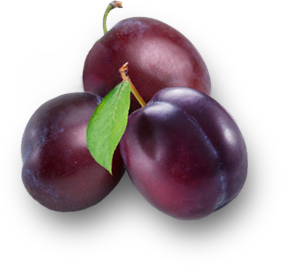| Stanley |
This cultivar matures at the end of August, or first half of September. The fruit is average in size (38g), with reverse egg shape; its exocarp is dark blue and the mesocarp is greenish-yellow, with juicy sweetish taste. This variety has taken primacy over POZEGACA cultivar, despite its less aromatic taste, not because of its size, but because it’s a carrier of plum pox virus, which ruins POZEGACA. |
| Čačanska rodna |
As the name states, this variety was created in Cacak in 1961, by cross-breeding of STANLEY and POZEGACA, and officially acknowledged in 1975. The fruit is gathered in the 3rd decade of August, it is of average size (28-42g), egg-shaped, with dark blue exocarp and firm, meaty yellow mesocarp, with aromatic sweet taste. Its use is diverse, and it’s especially convenient for drying. |
| Požegača |
This cultivar has the best quality fruit, which ripen at the end of August, or at the start of September. The fruit size is categorized as small (average 15-17g), it’s egg-shaped and has a crease over the longer side. The exocarp is dark blue and covered in epicuticular wax, while mesocarp is golden yellow, firm, but succulent, aromatic, sweet-sour and top quality. Its use is very diverse, due to its extraordinary reference. Due to its sensitivity to Polystigma rubrum, Tranzschelia pruni-spinosae, bladder plum gall, and especially to plum pox virus, further growing of this variety is not only limited, but most fruit growers are switching to more resistant cultivars. |
| Čačanska beauty |
Just like the previous variety, it was created at the Cacak Institute and officially acknowledged in 1975. It has an egg-shaped fruit of average size (40g), and it matures at the end of July or start of August. Exocarp is dark blue in color and covered in epicuticular wax, while mesocarp is greenish-yellow, firm in consistency and has sweet-sour taste. It’s used for industrial processing and consumption in fresh form. |



